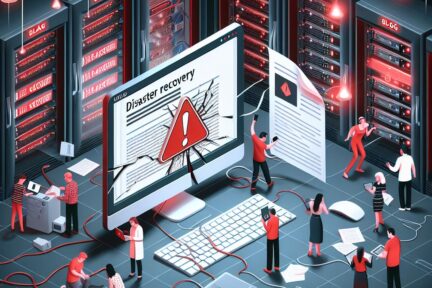In today’s fast-paced and highly competitive business landscape, efficiency is key to staying ahead of the game. With countless tasks and processes that need to be managed, staying organised and optimising productivity can be daunting. This is where an IT solutions company can make all the difference.
By harnessing the power of technology, these companies specialise in streamlining business operations, unlocking a new level of efficiency and effectiveness. From automating mundane tasks to integrating systems and providing seamless communication channels, IT solutions companies offer a range of services tailored to meet the unique needs of each business.
In this article, we will explore how an IT solutions company can transform your business, saving you time, money, and resources and ultimately allowing you to focus on what you do best – growing your business. So, let’s dive in and discover the untapped potential of unlocking efficiency with an IT solutions company.
Efficient business operations are the backbone of any successful company. Streamlining these operations improves productivity, enhances customer satisfaction, and drives profitability. When processes are disorganised or manual, valuable time and resources are wasted, leading to delays, errors, and missed opportunities. By streamlining business operations, companies can eliminate redundancies, automate repetitive tasks, and ensure smooth workflows. This allows employees to focus on more strategic and value-added activities, increasing productivity and overall business growth.
Efficiency not only affects internal operations but also has a direct impact on customer experience. When operations are streamlined, customers benefit from faster response times, smoother transactions, and improved service delivery. This enhances customer satisfaction and loyalty, ultimately contributing to business success. Streamlining business operations is crucial for companies thriving in today’s competitive landscape.
Before delving into how an IT solutions company can address these challenges, let’s first identify some of the common pain points that businesses face regarding operations. These challenges can vary depending on the industry, the organisation’s size, and the processes’ complexity. However, there are a few recurring issues that many businesses encounter.
One of the main challenges is the lack of integration between different systems and software used within the organisation. This leads to data silos, manual data entry, and inefficiencies in sharing information across departments. Additionally, businesses often struggle with outdated or legacy systems that can no longer meet their evolving needs. These systems may lack the necessary functionalities or integrations required for efficient operations. Furthermore, manual and paper-based processes are still prevalent in many organisations, resulting in time-consuming tasks, errors, and a lack of real-time visibility into operations.
Another common challenge is the absence of standardised processes and workflows. When each employee or department follows their own set of procedures, it becomes difficult to ensure consistency and optimise efficiency. Additionally, manual processes are prone to errors and delays, further hindering productivity. Inefficient communication channels, both internal and external, can also pose a challenge. A lack of collaboration tools and outdated communication methods can lead to miscommunication, delays, and an overall breakdown in information flow.
Now that we have identified the importance of streamlining business operations and the challenges that businesses commonly face let’s explore how an IT solutions company can help overcome these obstacles and unlock efficiency.
System Integration and Automation
An IT solutions company can assess the existing systems and processes within the organisation and identify opportunities for integration and automation. Information can flow seamlessly between departments by integrating various systems and software, such as customer relationship management (CRM), enterprise resource planning (ERP), and project management tools, eliminating the need for manual data entry and reducing errors. Automation can also be applied to repetitive tasks, freeing up valuable time for employees to focus on more strategic initiatives.
Custom Software Development
In cases where off-the-shelf solutions do not meet the specific needs of a business, an IT solutions company can develop customised software applications. These applications are tailored to address the organisation’s unique requirements and can streamline processes not adequately supported by existing software. Custom software development ensures businesses have the tools to optimise operations and achieve their goals.
Cloud Solutions and Infrastructure
Moving to the cloud can bring numerous benefits to businesses, including increased flexibility, scalability, and cost savings. An IT solutions company can help organisations migrate their systems and data to the cloud, ensuring a smooth transition and providing ongoing support. Cloud solutions enable employees to access information from anywhere, collaborate more effectively, and reduce the need for physical infrastructure. This streamlines operations and enhances data security and disaster recovery capabilities.
Communication and Collaboration Tools
Effective communication and collaboration are vital for streamlined operations. An IT solutions company can implement tools such as project management software, instant messaging platforms, and video conferencing to facilitate seamless employee communication and collaboration. These tools enable real-time information sharing, document collaboration, and efficient project management, ultimately improving productivity and teamwork.
Data Analytics and Reporting
Leveraging data analytics and reporting capabilities can provide valuable insights into business operations and identify areas for improvement. An IT solutions company can implement analytics tools and dashboards that allow businesses to monitor key performance indicators (KPIs), track progress, and make data-driven decisions. This enables organisations to identify bottlenecks, optimise processes, and continuously improve efficiency.
IT solutions companies offer a wide range of features and services that are designed to streamline business operations. These offerings can vary depending on the specific needs of each organisation, but some common features are typically included in their service portfolios.
Consultation and Assessment
IT solutions companies begin by thoroughly assessing the existing systems, processes, and pain points within the organisation. They work closely with stakeholders to understand the unique requirements and challenges and develop a tailored strategy for streamlining operations.
Software Development and Integration
IT solutions companies have expertise in developing custom software applications that address specific business needs. They can also integrate existing systems and software to ensure seamless data flow and collaboration.
Cloud Solutions and Infrastructure
Many IT solutions companies offer cloud migration services, helping businesses transition their systems and data to the cloud. They provide ongoing support and maintenance to ensure optimal performance and security.
Managed IT Services
IT solutions companies can provide ongoing support and maintenance for IT infrastructure, including servers, networks, and security systems. This allows businesses to focus on their core competencies while leaving the technical aspects to the experts.
Cybersecurity Solutions
With the increasing threat of cyberattacks, IT solutions companies offer cybersecurity services to protect businesses from data breaches and other security risks. These services include vulnerability assessments, network security, and incident response planning.
Training and Support
IT solutions companies often train employees on how to effectively use new systems and software. They also offer ongoing technical support to address any issues or questions that may arise.
When selecting an IT solutions company to partner with, several factors must be considered to ensure a successful implementation and long-term partnership.
Expertise and Experience
Look for an IT solutions company with a proven track record in streamlining operations and supporting businesses in your industry. Assess their expertise and experience in relevant technologies and solutions.
Customisation and Scalability
Ensure that the IT solutions company can tailor their offerings to meet your unique business requirements. Additionally, consider their ability to scale and adapt as your business grows and evolves.
Security and Compliance
Data security is of utmost importance. Verify that the IT solutions company has robust security measures in place and complies with relevant regulations and standards.
Support and Maintenance
Consider the level of support and maintenance provided by the IT solutions company. Ensure they have a dedicated support team that can address any issues or questions promptly.
Cost and Return on Investment
Evaluate the cost-benefit analysis of partnering with an IT solutions company. Consider the upfront investment, ongoing costs, and the potential return on investment regarding improved efficiency and business growth.
Implementing IT solutions to streamline business operations involves investing time, resources, and finances. However, the benefits and return on investment can far outweigh the costs. Conducting a cost-benefit analysis can help businesses evaluate the potential impact on their bottom line.
Some of the key factors to consider in the cost-benefit analysis include:
Time Savings
Streamlining operations reduces manual tasks and automates repetitive processes, saving valuable time for employees. This allows them to focus on more strategic initiatives that drive business growth.
Increased Productivity
By eliminating redundancies and optimising workflows, businesses can achieve higher productivity levels. This leads to increased output, faster turnaround times, and improved overall efficiency.
Cost Savings
Streamlined operations often result in cost savings. Businesses can minimise wastage and unnecessary expenses by automating tasks and reducing errors. Additionally, cloud solutions can eliminate the need for physical infrastructure, reducing maintenance and operational costs.
Improved Customer Satisfaction
Streamlined operations enable businesses to deliver better customer experiences. Faster response times, accurate order processing, and seamless communication channels increase customer satisfaction and loyalty.
Competitive Advantage
By streamlining operations, businesses gain a competitive edge. They can respond quickly to market changes, adapt to customer demands, and deliver products and services more efficiently than their competitors.
When conducting a cost-benefit analysis, it is important to consider both the short-term and long-term impact of streamlining operations with an IT solutions company. While upfront costs may be involved, the long-term benefits can significantly outweigh the initial investment.
Implementing IT solutions and integrating them into existing operations requires careful planning and execution. To ensure a successful implementation, businesses should follow these key steps:
Identify the Pain Points
Conduct a thorough assessment of existing operations and identify the pain points and areas that can be streamlined. Understand the specific needs and requirements of the business.
Set Clear Objectives
Define clear objectives and goals for streamlining operations. Identify the key performance indicators (KPIs) that will be used to measure success.
Select the Right IT Solutions Company
Choose an IT solutions company that aligns with the business requirements and has the expertise and experience to streamline operations in your industry.
Develop a Detailed Implementation Plan
Work with the IT solutions company to develop a detailed implementation plan that outlines the timeline, milestones, and responsibilities. Ensure that all stakeholders are involved and aligned.
Communicate and Train
Effective communication is crucial during the implementation process. Communicate the changes to employees, provide training on new systems and processes, and address any concerns or questions they may have.
Monitor and Evaluate
Continuously monitor the implementation progress and evaluate the effectiveness of the IT solutions. Measure the agreed-upon KPIs and adjust as needed.
Provide Ongoing Support
Ensure that the IT solutions company provides ongoing support and maintenance. Regularly assess the performance and make necessary updates to optimise operations.
Measuring the success and effectiveness of streamlined operations is essential to ensure continuous improvement and drive further efficiencies. Here are some key metrics and methods to consider when evaluating the impact of streamlining operations:
Key Performance Indicators (KPIs)
Define and track KPIs that align with the objectives of the streamlined operations. These can include metrics such as cost savings, productivity levels, customer satisfaction ratings, and turnaround times.
Customer Feedback
Gather feedback from customers to understand their experience and satisfaction levels. This can be done through surveys, interviews, or online reviews.
Employee Feedback
Obtain feedback from employees on the effectiveness of the streamlined operations. This can be done through surveys, focus groups, or one-on-one discussions.
Data Analysis
Leverage data analytics tools to analyse operational data and identify trends, patterns, and areas for improvement. This can provide valuable insights into the effectiveness of streamlined operations.
Benchmarking
Compare the performance of the streamlined operations against industry benchmarks or competitors. This can help identify areas where further improvements can be made.
By consistently measuring and evaluating the success of streamlined operations, businesses can identify areas for further optimisation and ensure continuous improvement.
Streamlining operations will remain a top priority as businesses continue to evolve and adapt to the rapidly changing business landscape—the role of IT solutions companies in driving efficiency and unlocking the untapped.
You need the best IT support in London. Technology is complicated and expensive. It’s so hard to maintain everything and know what to do when something breaks or goes wrong. IT problems can put a damper on your day. They’re frustrating, time-consuming, and seem like a never-ending cycle of issues.
Penntech’s average NPS score over 90 days is 84. The average Net Promoter Score (NPS) for IT Managed Service Providers (MSPs) can vary. Still, an NPS of around 50 is considered excellent in this industry, with scores above 70 exceptional and rare.
We offer our services on a trial basis for the first three months because we’re confident in our delivery and approach.
Penntech offers a wide range of IT services, from strategic project management to 24/7 remote support, ensuring all your IT needs are always covered.
We provide advanced cybersecurity measures and expertise, including penetration testing services and Cyber Essentials, to protect clients from cyber threats.
We offer Clients the ability to scale IT services up or down based on their needs. This flexibility is crucial for businesses that experience seasonal changes or rapid growth.
Other providers often enforce their preferred IT stack, but we don’t, as IT is not a one-size-fits-all solution.
We ensure our Clients’ business continuity through robust disaster recovery and backup solutions.
With experience in various verticals and industries, Penntech understands different businesses’ unique IT challenges and can provide customised solutions..
Contact us today or explore the range of support packages on offer.


Business owners often have to wear many hats, from handling HR and marketing tasks to managing the finances. One task…

Cool Windows 11 Features That May Make You Love This OS
Microsoft released the Windows 11 operating system (OS) over a year ago. It was well-received mainly with reviews as stable…

6 Ways to Prevent Misconfiguration (the Main Cause of Cloud Breaches)
Misconfiguration of cloud solutions is often overlooked when companies plan cybersecurity strategies. Cloud apps are typically quick and easy to…

4 Proven Ways to Mitigate the Costs of a Data Breach
No business wants to suffer a data breach, but unfortunately, it’s difficult to avoid them in today’s environment. Approximately 83%…

The benefits of AI include advancing our technology, improving business operations, and much more. Adoption of AI has more than doubled…

Leading Password Managers for Personal and Business
We hope that your business is already considering a password manager system, but there’s still the matter of finding the…

What’s Changing in the Cybersecurity Insurance Market?
Cybersecurity insurance is still a pretty new concept for many SMBs. It was initially introduced in the 1990s to provide coverage for large enterprises. It covered things like data processing errors and online media.

What are the advantages of implementing Conditional Access?
It seems that nearly as long as passwords have been around, they’ve been a major source of security concern. Eighty-one…

In today’s fast-paced digital landscape, businesses face numerous challenges in managing their IT infrastructure. Managed IT services have emerged as…

IT Support Tips for Office Managers
Practical Advice on Managing IT Issues Efficiently Managing IT support for office managers can be challenging, but with the right…

Top IT Remote Support Tools to Assist Team Members
In today’s increasingly remote and hybrid work environments, reliable remote support tools are essential for quickly and efficiently resolving IT…

Essential Components of a Disaster Recovery Plan for Office Managers
A well-crafted disaster recovery plan (DRP) ensures business continuity and minimises downtime during an unexpected disaster. As an office manager,…

How an Office Manager Can Maintain an Inventory of IT Assets
Maintaining an accurate inventory of IT assets is crucial for efficient management, cost control, and security within an office environment….

What an Office Manager Should Consider for Quality Hardware
Selecting quality hardware is essential for maintaining a productive and efficient office environment. As an office manager, you need to…

How an Office Manager Can Monitor IT Network Performance
Monitoring IT network performance is crucial for maintaining a smooth and efficient office environment. You may not have a technical…

Essential IT Policies for Office Managers
As an office manager, establishing comprehensive IT policies is crucial for maintaining security, efficiency, and compliance within your organisation. These…

IT Troubleshooting Guide for Office Managers
Basic IT Troubleshooting Guide As an office manager, you often need to address everyday IT issues to keep the office…